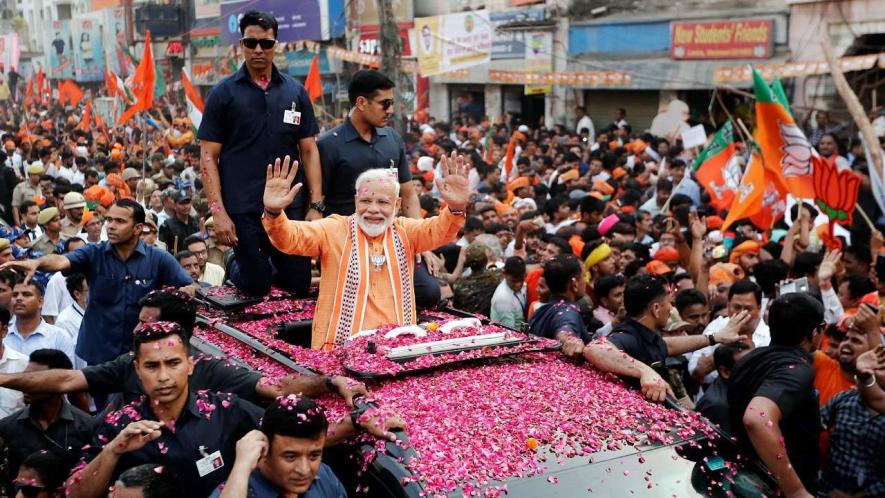What We Do Not Understand About 2019

Image Courtesy: DNA India
In analysing the stunning success of the Bharatiya Janata Party (BJP) and Narendra Modi, we need to unpack many issues that have no clarity. Analysts have steadfastly avoided these issues and, therefore, the reasons for Modi’s success are not very clear yet. It is often being touted that Modi is perhaps the most popular leader, surpassing even Jawaharlal Nehru and Indira Gandhi. Some might even go to the extent of comparing him with Mahatma Gandhi.
But why is Modi so popular and why does the electorate trust him so deeply? Actually, there is nothing unprecedented that he has done which can justify this kind of trust. Is it possible that the trust emerged and then sustained for his alleged role in the anti-Muslim pogrom in Gujarat in 2002? Do people feel he does what he says and does not hesitate? Is this the same narrative that was repeated during the Balakot air strikes where he again said ‘Ghus kar marenge’? (Will go there – Pakistan- and kill). Or did the trust grow much stronger and wider after he became the prime minister and is not directly linked to Gujarat 2002?
It is widely believed that the core constituency of the BJP is about 15-20%. Even when the party is not doing well, it is this core that does not desert them. Can we now argue that the core has expanded beyond 20% and has actually grown much wider? The core is ideologically committed to the project of Hindutva. Does it also now mean a much wider section of the population has become committed to the project of Hindu Rashtra or does it mean that outside of the 20%, the core is committed more due to Modi’s style of leadership but not necessarily to the project of Hindutva?
It is also not clear how development and Hindutva are going together. Will lack of development lead to a large section deserting the party, which is what it was believed to be till recently? But looking at the success of the 2019 elections, has the equation between development and Hindutva changed substantially? If so, how far can we stretch this logic? When people do not vote for reasons of lack of development, what happens to their commitment to Hindutva and Hinduism under threat? Are these momentary fears or, in fact, projected for reasons of convenience?
It is also not clear why a leader aspiring to become immortal in history has not matched his performance with the kind of support he enjoys. Modi had near complete control over the administration and he could have easily doled out a policy that he could be remembered for, like V.P.Singh is known for Mandal, LK Advani for his Rath Yatra, AB Vajpayee for his bus tour to Lahore. There is nothing that we can actually remember Modi for, except for this euphoric support, and if we stretch our memory a bit, for 2002.
Imagine, if without the economy doing well, this is the kind of support he has, what would it have looked like had it actually done well? Or is it possible that a serious policy frame and developmental activities are not possible given the ideological moorings of the BJP?
Second, does the project of Hindutva go with empowerment of the people or does it have to necessarily keep them disempowered socially and also economically? Is this the reason that there was a sustained attack on institutions of higher education under Modi? Can economic mobility and the kind of street mobilisation that Hindutva requires, go together? Is it not true that the Hindi heartland remained socially and economically backward because of Hindutva and, therefore, also is its central site of mobilisation? Is this the reason that BJP’s expansion is slower in the South? This, however, does not explain its popularity in Maharashtra and Gujarat.
Finally, it is also not very clear how the BJP under Amit Shah is able to spread its base in such a clinical fashion. Wherever the BJP wishes to expand its footprint, it is almost a foregone conclusion that it will begin and end with street violence. They did this in Tripura between the tribals and non-locals, and then in West Bengal between Hindus and Muslims in Asansol, and with the Trinamool Congress workers in the rest of the state. Yet, much of this violence is often described as spontaneous, followed by endless debates as to what triggered and who is responsible for it. When it looks premeditated, how does it become spontaneous in media coverage? If it is indeed not spontaneous, how does it invariably yield electoral results for the BJP? Why is that nowhere have people come together to reject this model of politics? Is there a tacit consent for violence? Are the insecurities and mistrust between the communities real and the violence manufactured, or is it the other way round?
Modi looks almost like a work of fiction -- surreal and unreal. He had predicted in 2014 that nobody can remove him from power till 2024. Did this confidence mar the way he governed the nation for the last five years? Have we just witnessed mis-governance because of stability? We do not as yet have the privilege of hindsight. It is important for individuals and events to become part of the history to be properly asserted. Modi, too, knows this but will he be able to also fix history?
The writers is Associate Professor, Centre for Political Studies, Jawaharlal Nehru University, Delhi. He recently authored the book- India after Modi: Populism and the Right. The views are personal.
Get the latest reports & analysis with people's perspective on Protests, movements & deep analytical videos, discussions of the current affairs in your Telegram app. Subscribe to NewsClick's Telegram channel & get Real-Time updates on stories, as they get published on our website.























